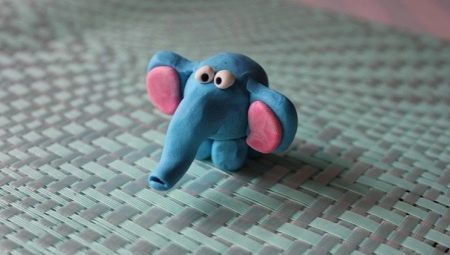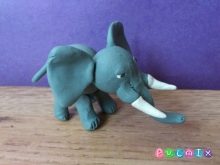Methods for sculpting an elephant from plasticine

Plasticine plays a very important role in a kid's life. In addition to fine motor skills, in the process of working with him, imagination and creative skills develop. It has a fruitful effect on rapprochement in communication with the baby. Most children love figurines of various animals, so the idea to mold an elephant from plasticine would be a good option.



Classic version
A homemade plasticine elephant will help your kid develop imagination. In addition, it will develop fine motor skills in the fingers. To start the process of creating a toy animal, you need to prepare a workplace and choose good materials.
Recommendations for the choice of plasticine.
- High-quality plasticine should warm up well so that the baby can work with it... For a child to be able to mold an elephant, it is advisable to choose a soft and lightweight material.
- Good plasticine does not delaminate... This will help the parts to be securely fastened together.
- High quality sculpting material, does not cling to hands and clothes due to the presence of natural wax in the composition.
- Plastic mass for children must be natural, and food components can act as dyes. It is not recommended to give formulations to children that contain toxic additives.
If a child at 3-4 years old is interested in modeling materials, it is worth choosing content with bright colors to develop children's color perception.


In addition to plasticine, the following materials will be required for the phased creation of an elephant:
- napkins;
- board for work;
- toothpicks.
For children of this age, you can print pictures where the plasticine elephant will be taken in steps. One of the classic options for making an elephant is the use of light plasticine. This plastic mass is self-hardening, which is its advantage. It is easy to sculpt and glue, and is also pleasant to the touch, which allows the child to enjoy working with plasticine. But such plasticine, with too long a process, can quickly solidify. Therefore, all work is best done without delaying the process.


First, you need to make small items, after which you can start collecting the toy. First of all, you need to make one large ball, and make a small dent with your fingers at the bottom. After that, stretch your head by smoothing the plasticine on the sides. Next, a sausage is prepared, which will become the trunk. It is attached to the top of the ball by curving the edge.



Then small balls are prepared to form the ears, which are also attached to the sides of the workpiece. At the end, add a small sculpture of tusks to complete the image. After the elephant is ready, and it needs to be dried for several hours so that you can play with it.



Another option for creating an elephant from plasticine is to use a kinder egg box. Such an elephant is very easy to do. At the first stage, the kinder box is covered with plasticine of the main color, since it will play the role of a body.
After that, it is necessary to form a small ball that will serve as the head of the animal. Ears, trunk and eyes are attached to the head.



Then you can start shaping the legs. Before starting work, you can put a small ball, bead or material in the kinder box, which will allow the toy elephant to ring. With the help of such simple methods, it will turn out to create an original rattle, which will harden after placing it in the freezer.



Modeling figurines with cones
Plasticine elephant can be molded using natural materials. Most often, chestnuts or cones are used for this craft. Natural materials are selected in such a way that one part is smaller than the other. The smaller one plays the role of the head, and the big bump or chestnut is adapted under the body. The process of creating a bump shape is simple.
Using additional materials, it is worth considering that the ears of an elephant should be equal in diameter to the head, and their shape should resemble one of the petals of a rosehip flower. Then you can proceed to making the trunk. A tube is prepared from plasticine, which is narrowed at one end. On the one hand, using a toothpick or plasticine knife, small folds are made, after which they give the trunk a curved look.



Eyes can also be made from plasticine. They will be round, like all crafts. You can then attach the trunk to a small bump or chestnut tree. After creating the head, proceed to creating the torso. If the body is also made from a bump, then it must be connected to the head using a short oval neck. The legs must be stable and capable of supporting the weight of the animal, made of plasticine and natural materials.
After attaching the legs to the body, place the elephant on a flat surface to check its stability. The end of the process will be to create a ponytail and attach it to the back.



How to make a little elephant?
A small child will not be able to mold an elephant from plasticine on his own; the help of an adult will be required. The parent will have to tell you how to make the animal figurine step by step so that the kid remembers the algorithm of actions. For those kids who know how to make plasticine balls, it will be easier to master this animal sculpture. The whole process can be divided into several stages.
First of all, it is necessary to roll a couple of balls with different sizes from the plastic mass. The large one will play the role of the torso, and the small one will act as the head of the elephant. At the next stage, you should ask the baby to make 3 small balls with his own hands, which will easily and simply turn into a trunk and ears.To make the trunk, roll the ball into a sausage. The balls intended for the ears are kneaded into a cake. After preparing the parts, they are attached to the head of the future elephant.



To create the tusks, you need to take a different color, for example, orange. The tusks are made in the form of small sausages and are attached near the trunk. After that, the location of the eyes is marked with a toothpick. Four balls are prepared from plasticine of the main shade, which will become legs. They are also rolled into sausages and connected to the body.
Then you can start making the tail. The plasticine must be rolled out on a board into a thin long sausage, which will be the final touch to the elephant sculpture. Depending on the wishes of an adult or a child, the elephant can be supplemented with eye decoration or a bow, stitched together for decoration.
The base can be of different colors.


Older children can be offered making an elephant from plasticine in the form of a picture. Volumetric sculpting is quite popular for children in the lower grades or the senior group of kindergarten. When using this technique, you need to find a solid foundation. This can be a glass surface, an unnecessary disc, a sheet of plywood, or high density cardboard. You will also need a simple pencil to create contours or a drawing printed on a printer.
It is worth choosing high quality plasticine for such a craft, since the child will have to work with wet hands.
- The first step is to make out the background of the picture.... To do this, plasticine is applied in small pieces to the surface and rubbed. With the help of some tools and varying degrees of pressure on the clay, you can create a relief surface.
- After preparing the background, a blank for the elephant is applied. When creating an animal from plasticine using this method, it should be borne in mind that it will be in the foreground, which means it should look much larger. It is also considered a small trick that thin plasticine parts can be applied by extrusion from a syringe.
- After completing the applique with the elephant, it is allowed to dry, and then covered with a protective varnish... In this way, dust can be prevented from entering the painting. This plasticine elephant should not be placed under a glass frame, as you can crush the main details.



You can make an elephant out of plasticine in any shade, depending on the child's wishes.... However, if he wants the elephant to look like a real animal, it is necessary to use gray, which most often comes in large sets. If the child has only a small box of plastic material, you can get a gray color by mixing black and white pieces until a uniform color.
Spending time with your child modeling animals will allow you to get a pleasant friendly atmosphere, develop the child's imagination, and develop fine motor skills of the hands. In addition to the elephant, other animals can also be molded from plasticine.


For information on how to mold an elephant from plasticine, see the next video.








